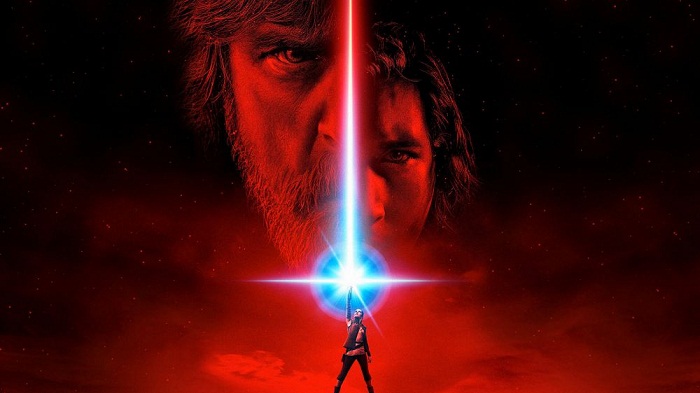
Even though the clips of Solo, the latest roll-out from the Star Wars juggernaut is doing the rounds and casting a followers mind away from its last release The Last Jedi, its thrill is very much vivid. The Episode VIII of the epic space opera series opened December last year and probed the adventures of Luke Skywalker whilst imparting the techniques of maneuvering the Jedi Forces to Rey, even as a seismic battle ensues in the galaxy.
As it is the norm with the Star Wars movies, The Last Jedi too featured certain spellbinding visuals that we couldn’t help but marvel; leaving us wanting for more of it. Acclaimed VFX studio Industrial Light and Magic were the chief helmers of the visual effects for the movie. Having delivered over 2000 shots, a sum of 87 of those was by its branch in Singapore and Alex Pritchard was the supervisor.
He now explicitly explains the scenes they worked on and their co-ordination with other ILM studios – “We shared work with both the San Francisco and London locations. We worked on the Battle of Crait with San Francisco. Our shots were primarily the ones where the actors were seen inside the ski speeders. With the London studio, we worked on shots of the Mega Destroyer and the escape ships being fired upon. These particular shots were some of our most difficult as they involved the complete destruction of the escape ships and we are incredibly pleased with the end result. The remainder of our work encompassed some great Star Wars moments for instance, Luke standing in front of the burning remains of destroyed Jedi temple or the exchange between Luke and Kylo inside the Jedi hut.”
With the UK and US studios of ILM too involved with the project, ILM Singapore had to co-ordinate well with their counterparts to ensure the smooth functioning of the work. But Pritchard feels that wasn’t a challenge at all. He says, “The coordination between facilities went quite smooth thanks to our amazing production team. Most of our work was shared with the San Francisco location and since we have worked together on many projects, the back and forth was fairly straightforward. There’s a shorthand that develops over time and we are able to communicate with great efficiency because of that. Because Singapore sits between the time zones of SF and Lon there were a few times where we needed to be available on both ends of our workday but that’s what happens when you’re part of a truly global effort.”
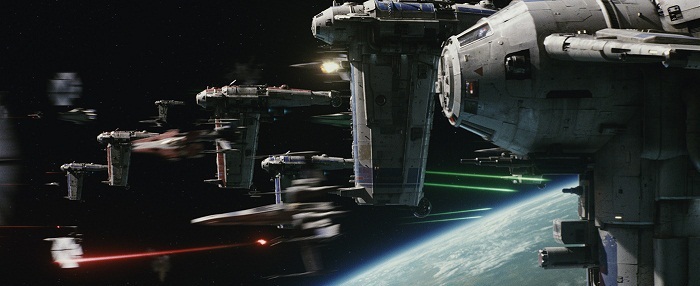
One of the decisive moments in the movie was the battle sequence involving the Mega Destroyer and how it culminated into mass destruction of the escape ships. Not only was it gripping to witness, but also difficult to shoot. Just ask Pritchard, who deems that as among the “most challenging” scenes. He elaborates, “Some of the most challenging shots for my team included the destruction of the escape ships that I mentioned earlier. These were the shots where the Mega Destroyer was firing huge cannon and picking off the transports one by one. The main challenge here was dealing with the scale of the elements in the shots and making sure the Mega Destroyer felt massive, as did the cannon that it was firing. To sell this, we made sure that the Mega Destroyer has small-scale detail and the cannon projectile was slow enough to feel large and impact full.
“Another challenge was the destruction of the ships once the projectile impacted. We used rigid simulations to break up the ships and then layered atop other simulations for smoke, fire, shooters and sparks. We referenced classic Star Wars explosions from A New Hope and then modified the look to have directionality to work with the aesthetic of the Mega Cannon. We knew we would have to repeat this process for numerous explosions so our FX team leveraged a sequence set up,” he added.
“We were quite pleased with the end result and the fact that we were able to remain true to the language of Star Wars while adapting it to fit into this new chapter.”
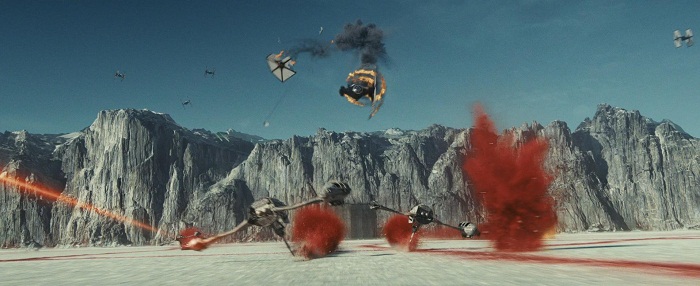
The Last Jedi also probed the tensions between the First Order and the Resistance. Whilst the latter claimed the Starkiller Base, the military junta counter-attacked and led an all-out assault at the 34ABY that was termed The Battle of Crait which resulted in a First Order victory. The sequence was pivotal to the narrative of the film and ILM Singapore is at the credits for the colossal encounter that left the audience breathless.
“We split this sequence with the team in San Francisco. Our work on the sequence consisted primarily of the shots where we see the actors were inside the cockpits of the ski speeders. These were challenging shots as they were shot on green screen and the set ski speeder that was built fell off into darkness away from the actors. Because the sequence was daylight and the set was not an exact match, we ended up replacing most of the exterior of the ski speeders. This involved replacing engines and wings as well as giving them movement that felt more natural for the speed they were travelling. We also needed to add glass and reflections to enclose the actors. This was tricky because this was an action sequence so you needed to be mindful of what was reflecting and when – for example, a blaster from a proceeding shot or maybe debris and smoke,” Pritchard elucidates.
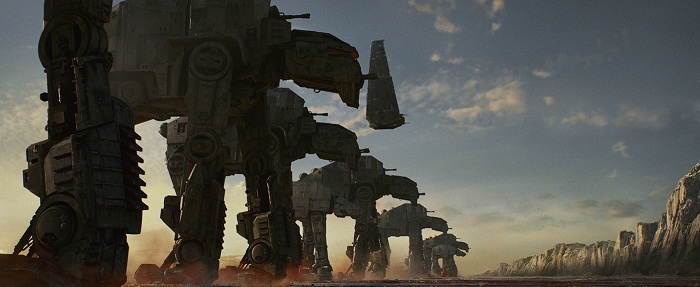
“Our Lighting TDs (Technical Directors) did a great job of providing various reflected elements that the Composting team could mix and match to work within the evolving cut. For the background we relied on our generalist and FX teams. Our generalists used reference from the salt flats in Bolivia to create and render a fully digital environment. Also they took into consideration continuity by making sure to add history trails from the battle and damaged ships burning in the distance.”
Remember the red dust clouds released from the ski speeders when they jetted across the battle landscape? The FX team apparently came up with it and the supervisor is elated with the way it all panned out when he exults, “We are truly happy with our work on this sequence and hopefully you would never know that we replaced most of those live action ski speeders.”
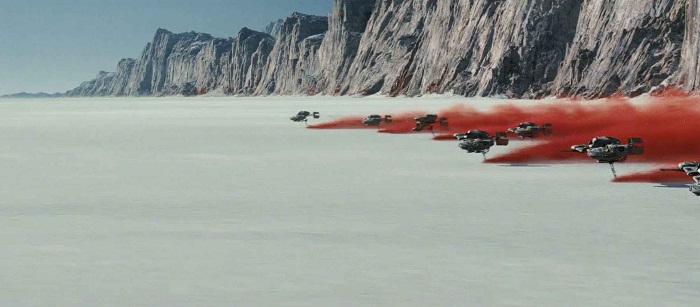
Whilst the shots were computerised, the locations were real as Pritchard said the Battle of Crait was shot from a reference of the extensive salt flats in the Latin-American region of Bolivia, which was later used to build a digital environment that’s alike in appearance and choreograph the battle better. Other sequences were filmed in Ireland and many in the United Kingdom.
Being heavy on VFX, The Last Jedi didn’t just call for some intensive work, but a lengthy one as well as the Singapore team was apparently involved in the project for around 9 months. “The team in Singapore was a good mix of strengths that accompanied the work well. We had some junior artists that had the opportunity to step up and work on solid mid-level shots as well as senior artists that were able to tackle the more iconic one off challenges and also mentor the more junior artists,” said Pritchard as he sums up the team spirit while pulling off one of the iconic scenes of the movie.

